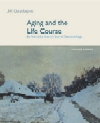1. How is a population's age structure related to its stage of economic
development?
The population age structure indicates the relative proportions of older, middle-aged,
and younger people within a population; it is often illustrated by a population
pyramid. Populations can be classified as predominately young, middle-aged,
or old, depending on the age structure that results from their fertility and
mortality rates. A population ages through a process known as the demographic
transition, in which economic development causes a fall in both fertility and
mortality rates. Developed countries such as the United States, Sweden, and
Germany have relatively old populations, whereas developing nations in Africa
and parts of Asia have relatively young populations. An important aspect of
the population age structure is the total dependency ratio, the combined ratio
of children and old people to people of working age. 2. What is the relative life expectancy of men versus women, and how
is it related to the sex ratio?
Life expectancy is the average number of years people in a given population
can expect to live, or more precisely, the mean age at death. In most nations,
women live longer than men-six to eight years longer in developed countries,
and three to five years longer in developing countries. The sex ratio is the
number of males to every 100 females. At birth males outnumber females about
106 to 100, but because women live longer than men, the sex ratio declines with
age until elderly women greatly outnumber elderly men. 3. In the United States, how have fertility, mortality, and migration
rates changed over the past century, and what has been the effect on the nation's
population?
In the United States after World War II, rising fertility rates created a baby
boom. Fertility began to decline in the 1960s with the introduction of the birth
control pill and increased levels of education and employment among women. It
reached an historic low in the early 1970s, creating what demographers call
a baby bust. The twentieth century also brought dramatic declines in mortality
rates. Medical advances against infant and childhood diseases began the trend;
later, improved treatments for heart disease lowered mortality rates among older
people. The result has been population aging and an evening out of the population
pyramid. Two waves of migration to the United States occurred during
the twentieth century: the first, around the beginning of the century, from
Italy and central Europe, and the second toward the end of the century, from
Latin America and Asia. Because most of these immigrants were young, they changed
the nation's age structure, increasing the proportion of younger people to older
Americans. Overall, the nation's total dependency ratio has been falling since
World War II. The composition of the dependent portion of the population is
also changing: once the majority of dependents were children, but soon, when
immigrants and baby boomers retire, the majority of dependents will be elderly. 4. How has life expectancy in the United States changed over the past
century, and does it differ from one group to the next? Over the past
100 years, life expectancy in the United States increased from about 47 years
to over 75. Life expectancy varies significantly with both race and gender.
On average, whites live longer than African Americans, and women live longer
than men. Because women's life expectancy has increased faster than men's, the
sex ratio has declined, from 101.1 to 100 in 1910 to only 65 to 100 in 1990. 5. How do older Americans compare to other Americans in terms of marital
status, income, and education?
Elderly women are significantly more likely than younger women to be single,
simply because they live longer than men. And because they tend to marry older
men, they are not likely to remarry after being widowed. On average, the elderly
receive less income than all but the youngest working people, but are less likely
to be considered poor. Yet poverty rates among older women, especially minority
women, are very high. Though today's elderly have lower levels of education
than younger generations, the knowledge gap is narrowing. The next generation
of elderly will have higher levels of education than their parents did. 6. Why do older Americans move, and where do they go?
Young retirees tend to gravitate to warmer climes in search of a more carefree
lifestyle. Thus many older Americans from the Midwest and the Great Plains states
move to the Sun Belt states. Later in retirement, after an illness or the death
of a spouse, many Americans make a second move to be closer to their children.
Those who live longest may make a third move, to a nursing home or assisted
living facility. |



 2002 McGraw-Hill Higher Education
2002 McGraw-Hill Higher Education